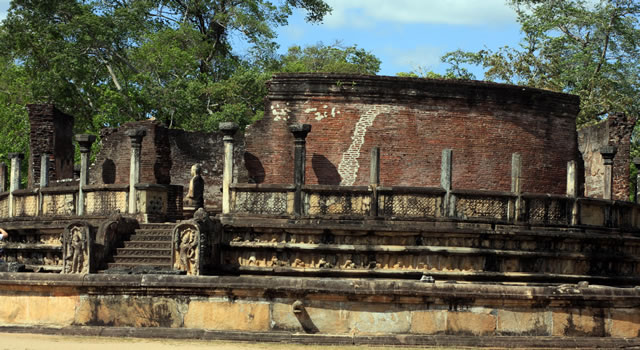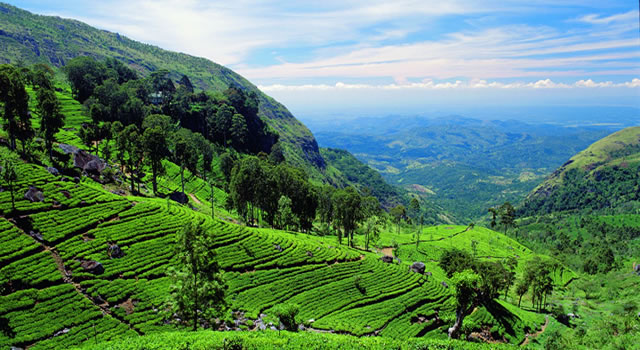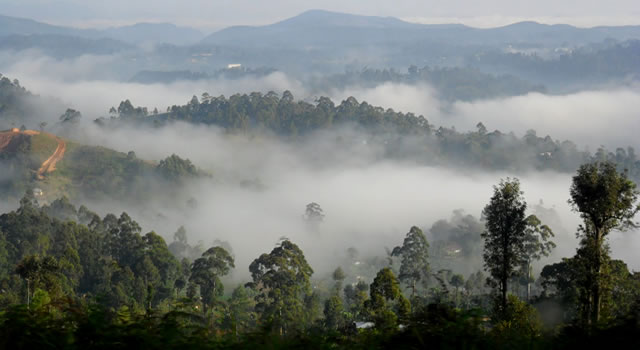The touristic interests of inland Sri Lanka are basically divided in the Cultural Triangle with it's amazing selection of lost cities, ancient temples and holy sites and the Tea Country, a showcase for all the natural riches and exotic beauty Sri Lanka is known for. Waterfalls, Cloud Forests, Colonial Architecture and, of course, the endless tea plantations growing the world famous Ceylon Tea. All this combined with some of the finest National Parks in Sri Lanka, makes a trip through the hill country an experience of a very special kind.
The Cultural Triangle includes (to name the most important ones) the ancient cities of Anuradhapura, the
famous Sigiriya rock fortress with the "cloud girls" frescos, the rock temple caves at Dambulla, the ancient capital of Polonnaruwa and the cultural capital of Sri Lanka, Kandy.
Kandy was not only the last Royal Kingdom to resist the British, it is also the location of the world famous Temple of the Tooth Relic (A Buddhist holy site).
Anuradhapura, a UNESCO World Heritage site, is famous for its well preserved ruins. From the 4th century BC until 1017 AD, Anuradhapura was the first of the ancient capitals of Sri Lanka. One of the most stable centres of power and urban life in South Asia during this time.
Today, Anuradhapura is surrounded by monasteries covering a large area of over 40 square kms and considered sacred to the Buddhist world.
Sigiriya - The magnificent rock fortress of Sigiriya is visible for miles from all directions and dominates the surrounding plain. Another UNESCO world heritage site, the Sigiriya Complex consists of the central rock, which arises abruptly 200 meters above the surrounding plain with the two rectangular precincts on the east and the west. The rock is surrounded by two wide moats, where crocodiles were introduced in ancient times and three ramparts. The moats and walls that surround the lower palace are still exquisitely beautiful.
Dambulla Rock Caves are the largest and best preserved cave temple complex in Sri Lanka. The Dambulla rock towers 160 m over the surrounding plains. There are more than 80 documented caves in the surrounding areas. Major attractions are spread over 5 caves which contain both statues and paintings related to the life of Lord Buddha and his life. There are a total of over 150 Buddha statues, 3 statues of srilankan kings and 4 statues of god and goddess. The latter 4 include two statues of Hindu gods, Vishnu and Ganesh. The murals cover an area of 2,100 m².
Polonnaruwa is the second of the ancient of kingdoms in Sri Lanka, after the first capital of Anuradhapura was abandoned in 1070, when it was ransacked by the Chola invaders from South India.
The city reached a dazzling but pitifully brief zenith in the 12th century and though ravaged by invasion in the centuries following, much evidence remains of the old grandeur and glory.
The ruins of the ancient city stand on the east shore of a large artificial lake, the Topa Wewa Lake, or Parakrama Samudra (the Sea of Parakrama), created by King Parakramabahu I (1153-86), whose reign was Polonnaruwa's golden age. Within a rectangle of city walls stand palace buildings and clusters of dozens of dagobas, temples and various other religious buildings.
Kandy - see below...
Kandy in the midst of hills in the Kandy plateau, which crosses an area of tropical plantations, mainly tea. Kandy is certainly one of the most scenic cities in Sri Lanka.
As capital of the Central Province is renowned for its culture and beauty and sacred to all Buddhists, as the “Dalada Maligawa” (the Temple of the Sacred Tooth Relic of the Lord Buddha) is situated in the heart of Kandy town. The world-famous Esala Perahera, a cultural pageant venerating the Tooth Relic of the Lord Buddha, is a spectacular parade which goes on for ten nights in the month of August and features up to a hundred colorfully adorned elephants, highly skilled acrobatic Kandyan dancers and traditional drummers.
The undisputed tea capital of Sri Lanka, Nuwara Eliya is surrounded by hills and tea plantations. Due to the fact that Nuwara Eliya enjoys spring-like weather throughout the year it became a favourite retreat of the British during colonial times.
The town is dotted with English country style houses and half-timbered bungalows, with names like Sunhill Cottage or Windsor Hotel. No surprise it’s earned the name "Little England".
The Holy Trinity Church might have stepped out of any village in England, with its Gothic architecture and eclectic collection of memorials, while the “pink post office” features a clock tower.
The Grand Hotel, Hill Club and Golf Club also hark back to a previous era, where tea by a log fire, overlooking the lawns with topiary and roses, might be followed by a spot of billiards. The golf course is open to visitors.
For a picturesque stroll, stop by the well-maintained Victoria Park or head for Gregory’s Lake, which is located just south of the town. You can also hire boats here.
Alternatively, for a bit of local colour, Bale Bazaar is where the locals head to stock up on warm clothing.
In April and May the town is crowded with Sri Lankans attending dressed in their finery for the Derby at the Turf Club; at other times of the year it’s much quieter, with apparently stray horses quietly wandering along the road.
Ella is a beautiful small village in Sri Lanka's hill country with little more than a handful of shops, hotels and guesthouses, but it has an almost perfect climate and occupies a very scenic vantage point, with views on a fine day stretching right across the South Coast of Sri Lanka.
As if view's weren't enough, Ella is sourrounded by hills perfect for walks through tea plantations to temples and waterfalls.
Ella also boasts three locations linked to the Hindu Epic Ramayana, where local legend claims Ravana was hiding Sita.
First there is the Ravana Ella Cave, located at the massive Ella Falls; a breathtaking 1080 feet high waterfall that cascades into several falls. The rocky undergoes of the waterfall is Khondalite, a kind of limestone which undergoes faster decay as hard gneiss or granite.
This has resulted in many caves being formed near the falls. King Ravana is said to have lived in one of the caves above the waterfall. A nearby pool bored out of the rock by the gushing waters is where Sita is said to have bathed Ravana.





